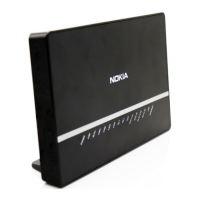FD 100/320Gbps NT and FX NT IHub Services Guide Virtual Private LAN Service
Issue: 13 3HH-11985-AAAA-TQZZA 191
•
The service ID must be unique to the service domain. Specifying an existing
service ID enters the editing context for that service ID.
• The admin status is down when the service is created and must be enabled using
the no shutdown command.
The following conditions apply when creating an m-VPLS:
• Only one m-VPLS can be configured for a ISAM system. RSTP or MSTP
instances (VLAN groups) can be configured for the m-VPLS after it is created.
• A VLAN ID must not be specified.
The following conditions apply when creating a v-VPLS:
• Single-tagged VLANs or a null VLAN (for untagged frames) can be specified.
• The v-VPLS VLAN ID cannot already be used by another v-VPLS nor be an value
internally used. The following VLAN ID values are used internally and may not be
used for v-VPLS: 4094, 4092, 4091 and 4090.
• Several v-VPLS instances can be configured in the system. The system supports
at least 4 K instances of v-VPLS.
• A v-VPLS is automatically connected to the virtual port at creation time, without
further operator action.
• User-to-user communication for users situated on distinct SAPs is disabled.
• MAC learning is enabled.
• Restricted MAC move is enabled (i.e MACs learned on regular ports overrule
MACs learned on residential ports; MACs learned on residential ports cannot
override MACs learned on regular ports).
• MAC aging is 300 seconds. The MAC aging can be modified but not disabled.
The following conditions apply when creating a VPLS:
• Only single-tagged VLANs can be specified.
• Several VPLS instances can be configured in the system. The system supports at
maximum 1K VPLS instances.
• User-to-user communication for users situated on distinct SAPs is disabled.
• MAC learning is enabled.
Note — User side relates to v-VPLS SAPs constructed on
residential ports and network side relates to v-VPLS SAPs
constructed on regular ports.
Note — User side relates to VPLS SAPs constructed on
residential ports and network side relates to VPLS SAPs or
SDP bindings constructed on or associated to regular ports.

